#margaret of burgundy
Photo
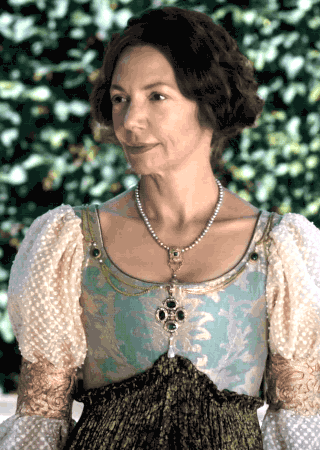
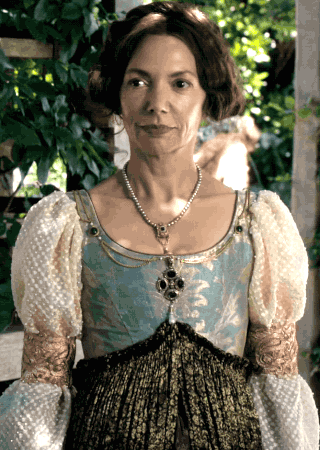




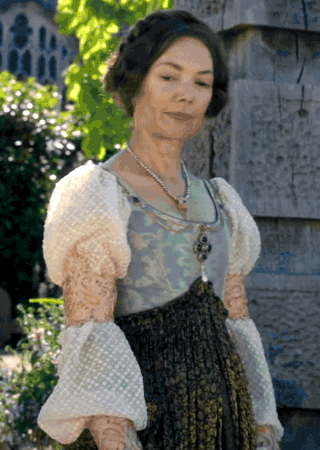


(Almost) Every Costume Per Episode + Margaret of Burgundy’s blue, white and gold gown in 1x03
#The White Princess#TheWhitePrincessEdit#perioddramaedit#weloveperioddrama#period drama#costumeedit#Margaret of Burgundy#Burgundy#costumes#costume drama#Almost Every Costume Per Episode#historical drama#Awkward-Sultana
45 notes
·
View notes
Text
"Margaret (of York, Duchess of Burgundy) left Bruges on 24 June and was in England for more than three months. She travelled with a large retinue headed by Guillaume de Baume and the embassy included two officials who were well-known to her, Thomas Plaines and Jean Gros, the treasurer of the Order of the Golden Fleece. She received aides from the Estates to cover her expenses with the Hainault Estates contributing 4,000 livres. Her mission had several goals, but the immediate need was to obtain some military help in the form of English archers to reinforce Maximilian’s hard pressed armies.
... King Edward sent Sir Edward Woodville, the Queen’s younger brother, aboard the royal ship ‘Falcon’ to bring his sister across the Channel. It was twelve years since she had sailed to her marriage. Sir Edward had been part of her marriage party and he had won the honours in the famous joust of the Golden Tree. This time Margaret took the shorter route from Calais to Gravesend, where she was received by Sir John Weston, the Prior of the Knights of St John. She then transferred to a royal barge which had been sent to bring her up the Thames to London.
The barge was specially refitted for the occasion. The master and the twenty-four oarsmen had been supplied with new liveries in the Yorkist colours of murrey and blue with white roses embroidered on their jackets. The knights and squires who formed the escort of honour wore fine black velvet jackets which were decorated with a pattern of silver and purple. Two residences had been prepared for Margaret’s use, the palace at Greenwich where she had spent so much time before her marriage, and the London house of Coldharbour near her mother’s home at Baynard’s Castle. New beds with red and green hangings had been sent up to the Coldharbour house and the finest bedlinens and coverlets had been ordered. Curtains, screens and tapestries were provided for both the houses, including a piece of arras which depicted the story of Paris and Helen. For her travel during her stay in England, Margaret was sent ten ‘hobbeys and palfreys’ all newly harnessed and caparisoned in rich saddle cloths. The King encouraged everyone to be generous towards his sister and used ‘right large language’ with the Archbishop of Canterbury who failed to offer Margaret a gift. His own final present to his sister was a luxurious pillion saddle in blue and violet cloth of gold, fringed with ‘Venetian gold’ thread.
While she was in England, Margaret renewed her contacts with all her old friends and family. She was received by the Queen and introduced to her royal nephews and nieces. Her youngest brother Richard, Duke of Gloucester, who was busy dealing with Scottish incursions in the north, made time to come south to see his sister, and the King gave a state banquet at Greenwich in honour of Margaret and their mother, the old Duchess Cecily. It was also attended by Margaret’s sister Elizabeth, Duchess of Suffolk. It seems that Margaret admired the wine, for on the day after the banquet, Edward sent her ‘a pipe of our wine’ valued at 36s 8d. As well as enjoying the company of her living family, Margaret could not have failed to remember all her dead relations. It was perhaps with a chantry in mind that she persuaded Edward to introduce the reformed Order of the Observant Friars into England. Soon after her departure the King sent for the Vicar-General of the Order and offered him a site for their new monastery near to the palace of Greenwich. Building began in 1482 and the abbey chapel was dedicated to the Holy Cross. Was the dedication in honour of Margaret, and does it provide further evidence of her connection with Waltham Abbey?
... Well satisfied that the negotiations were at last completed, Margaret prepared to leave London. She paid a farewell visit to the city where she was presented with a purse containing £100. She then set off for the coast accompanied by her brother Edward who had decided to see her on her way.
... The Dowager passed a week in Kent visiting the shrine of St Thomas à Becket and staying on the private estates of Anthony Woodville, Lord Rivers. These two bibliophiles must have had much in common especially now that Rivers was the patron of Margaret’s former protégé, William Caxton. No doubt she was shown Woodville’s translation of the ‘Dictes and Sayings of the Philosophers’ which was one of the first books printed on Caxton’s press at Westminster. With the King still in attendance, Margaret finally left for Dover, where the ‘Falcon’ waited to take her back to Calais. Edward seemed to be genuinely sad to see her departure and he wrote to Maximilian on 22 September announcing the return of his ‘well-beloved sister’. She left behind her in England Jacques de la Villeon, who was to act as an agent for the Burgundian ally, the Duke of Brittany."
Christine Weightman, "Margaret of York: The Diabolical Duchess"
#historicwomendaily#margaret of york duchess of burgundy#margaret of york#margaret of burgundy#15th century#english history#my post#everyone knows about the politics. let's focus on the personal#Edward getting annoyed at the Archbishop for not giving his sister a gift dkjsksks#I wish the York sisters were talked about more; they need more attention. Margaret especially is so interesting#and I wish Edward's relationship with his sisters was talked about more as well because he seems to have been very sweet and supportive#he seems to have involved Margaret in her marriage negotiations and randomly decided to accompany her on a pilgrimage before she set off#she was specially singled out in gratitude & praise after he reclaimed the throne in 1471 above all others. + everything in this excerpt#I recall reading that some positions were granted jointly to Elizabeth & John de la Pole to be held only during her lifetime but idr which#and everything about Anne of York is hilarious. His indulgence of his siblings did not begin with his brothers; it clearly began with her#she was given all of her exiled husband's attained estates to hold in her own right during her lifetime#and the act that allowed them to be inherited by heirs of 'her body' regardless of whoever their father was (lol)#he also seems to have been pretty chill/supportive of her affair with Thomas St. Leger; he and Thomas were certainly friendly#George of Clarence was also the one to host Anne's divorce proceedings presumably with Edward's approval#on the other hand Richard's 1484 Parliament denounced her and Thomas's marriage as one 'made by sedicious means' :/#anyway i got deviated#I like that Elizabeth Woodville formally received her! and that she and edward chilled with anthony for a week!
16 notes
·
View notes
Text
“Tudor historians ... write at length about Margaret (of York)’s involvement in the plots against Henry VII. They presented all attempts to overthrow Henry as part of her own malicious and obsessive vendetta against him. Polydore Vergil expressed the general view most succinctly when he stated that Margaret, ‘pursued Henry with insatiable hatred and with fiery wrath never desisted from employing every scheme which might harm him as a representative of the hostile faction.’
Edward Hall, who followed Polydore Vergil very closely, elaborated on this and added several fearsome phrases for ‘this diabolicall duches.’ Margaret was ‘lyke a dogge revertynge to her olde vomyte’ and ‘lyke a spyder that dayly weaueth when hys calle is tarne’. Hall examined the dowager’s motives in a paragraph which has been echoed by many later historians:
This lady Margaret although she knewe the familye and stocke of the house of Yorke to be in maner distroyed & vtterly defaced by her brother kyng Richard, yet not being saciate nor content with the long hatred & continual malice of her parentes which subuerted and ouerthrew almost the progeny and lignage of kyng Henry the vi and the house of Lancaster, nor yet remembryng the newe affinitie & strong alliaunce that was lately concluded, by the whiche the heyres of bothe the houses and progenies were vnited & conioyned together in lawfull matrimony, lyke one forgetryng bothe God & charite, inflamed with malice diabolicall instinction, inuented & practiced all mischiefes, displeasures and damages that she could deuyse against the kyng of England. And farther in her fury and frantyke moode (accordyng to the saiyng of the wise man, there is no malice equiualent nor aboue the malice of a woman) she wrought all the wayes possible how to sucke his bloud and copasse his destruccion as the principal head of her aduerse parte & contrary faccion, as though he should be a dewe sacrifice or an host immolated for the mutuall murder & shamefull homicide comitted and perpetrated by her brother and progeny.
In this extract Hall elevated Henry by comparing him with the sacrificial Lamb of God, and relegated Margaret firmly to the role of the devil’s agent.
Another major analogy for the Dowager, which became entrenched in the history books, originated with Bernard André, the blind tutor of Prince Arthur, Henry VII’s eldest son. As befitted a classical scholar he portrayed Margaret as the goddess Juno, notorious for her implacable desire for revenge, ceaselessly attacking the noble Henry who was cast in the role of Hercules. In the ‘Twelve Triumphs of Henry VII’, an epic poem also ascribed to André, Margaret was also compared to Menalippe, the Queen of the Amazons, another of Hercules’ enemies, and also to one of the heads of the monster Geryon, the other two heads being those of Philip and Maximilian. Here at least there was a recognition of how closely Margaret worked with the rulers of Burgundy.
...More recent English historians have echoed the Tudor line with considerable regularity. Even the charitable Hume considered that the Dowager’s behaviour towards Henry showed ‘a spirit of faction who entrenched somewhat the probity which shone forth in other parts of her character’. For Professor Mackie, Margaret was ‘always ready to play the kindly aunt to Henry’s enemies’. Writers in other fields have picked up this general verdict. The art historian, Professor Wilenski, suggested that Dirk Bouts portrayed Margaret as the wicked queen in his great dyptich ‘The Judgment of Otho’ because she was ‘rancourous and given to political intrigue’.
The source for all these opinions on the Dowager’s character was no less a person than Henry VII himself. He expressed his attitude towards Margaret with great conviction in a letter written to Sir Gilbert Talbot in 1493:
"not forgetting the great malice that the Lady Margaret of Burgundy beareth continually against us, as she showed lately in sending hither a feigned boy surmising him to have been the son of the Duke of Clarence … And forseeing now the perseverance of the same her malice, by the untrue contriving eftsoon of another feigned lad called Perkin Warbeck … wherethrough she intendeth by promising unto the Flemings and other of the Archduke’s obeissance to whom she laboureth daily to take her way, and by her promise to certain aliens, captains of strange nations, to have duchies, counties, baronies, and other lands, within this our royaume to induce them thereby to land here."
The King repeated his opinions in his instructions to his ambassador to France, who was told to inform the French King that the Dowager was misleading Maximilian and was wholly responsible for the past and for the threatened invasions of England. Although Henry had, by this date, very valid reasons for regarding Burgundy as a source of danger, his motives for accusing the Dowager rather than Maximilian were entirely diplomatic and totally ignored the fact that Margaret and Maximilian worked very closely together in their attempts to dethrone Henry.
Henry VII had an exaggerated notion of Margaret’s political influence, although he was not the first to respect and fear her authority. Louis XI of France had emphasised her role in diplomatic affairs and from the moment of her marriage to Duke Charles, the French King had regarded her as an active agent of the Anglo-Burgundian alliance. After 1477, Louis recognised the Dowager as one of the most vigorous opponents of France [...].
- Christine Weightman, “Margaret of York: the Diabolical Duchess”
#history#margaret of york#margaret of burgundy#the wars of the roses#historicwomendaily#house of york#tudor#tudor era#queue#mine
29 notes
·
View notes
Link
Made what is undoubtedly the nerdiest fanvid I've ever done (see the end), featuring The White Queen and The White Princess.
#richard iii#edward iv#george duke of clarence#aneurin barnard#max irons#david oakes#anne neville#elizabeth woodville#isabel neville#the white queen#the white princess#sons of york#wars of the roses#richard x anne#edward x elizabeth#george x isabel#richard duke of gloucester#warwick the kingmaker#richard neville#margaret of burgundy#henry vi#margaret of anjou#margaret beaufort#henry vii#elizabeth of york#princes in the tower#edward v#margaret pole#edward of warwick#perkin warbeck
14 notes
·
View notes
Photo

#Knightfall#knightfalledit#perioddramaedit#clementine nicholson#margaret of burgundy#my edits#stills
31 notes
·
View notes
Text
Been reading about Jacqueline of Hainault's mother, Margaret of Burgundy, and came across this paragraph:
According to some chronicles, Margaret was involved in a conspiracy to murder her nephew [Philip the Good Duke of Burgundy] in this period. A member of her entourage, the Hainault nobleman Gilles de Potelle, was convicted for it in May 1433. Margaret’s actual involvement is unclear, but it does not seem completely unlikely, in view of the political climate of the period, and of other conspiracies and political murders in which Margaret and her daughter Jacqueline were possibly involved.
Margreet Brandsma, "Riches and power? Princely widows in the Burgundian period. The case of Margaret of Burgundy (1374–1441)", The Medieval Low Countries 5
when we will get a novel about these ladies we deserve featuring mother/daughter bonding via plotting assassinations?
#margaret of burgundy#jacqueline of hainault#philip the good duke of burgundy#medieval low countries#historian: margareet brandsma#in all seriousness i do have a lot of respect for jacqueline and her mother
2 notes
·
View notes
Note
Can you do Queen Joan, Princess Isabella and Queen Margaret’s clothes from Knightfall (2017-2019)?
I never watched past the first episode bc it was too male-coded for my personal taste but I think I already have a request for Isabella anyway. I will see what I can do.
4 notes
·
View notes
Text
Figures Hidden in a Royal Book
BL Royal 19 E V is a medieval manuscript that once belonged to Edward IV. It was compiled for him in Bruges in 1480. The content is the Romuleon, a translation of a history of Rome, and amongst the tales of Emperors and Empresses, it contains the symbols of its royal owner–the Arms of England, an image of the Garter, the motto ‘Honny soit qui mal y pense’ (note the unstandardised medieval…

View On WordPress
#"Princes"#adoption#British Library#Bruges#Edward IV#Hadrian#Henry VIII#libraries#manuscripts#Margaret of Burgundy#mottoes#murrey and blue#Order of the Garter#Plotila#Richard Duke of York#Richard III#Roman Emperors#Romuleon#royal arms#Trajan
3 notes
·
View notes
Text
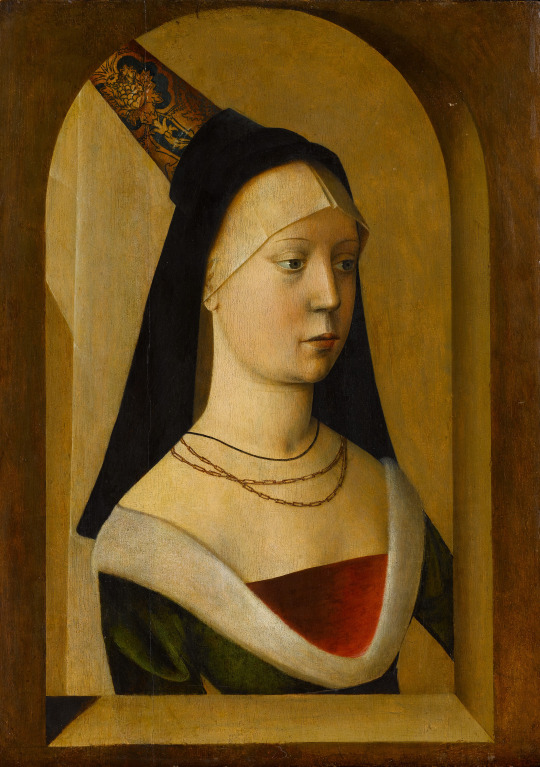
Netherlandish/French, 15th century
Portrait of a Lady ca.1470-80
The Metropolitan Museum of Art
Previous scholarship offers two unconvincing suggestions as to the sitter's identity: Margaret of York (1446 -1503), Duchess of Burgundy, and Mary of Burgundy (1457 -1482), Margaret's stepdaughter. The picture remains without a secure attribution, preserving, somewhat unfortunately, the air of mystery surrounding the portrait.
#netherlandish#netherlands#1400s#art#european history#european art#fine art#classical art#europe#european#oil painting#fine arts#europa#mediterranean#france#french#french art#netherlandish art#margaret of york#mary of burgundy
26 notes
·
View notes
Text
Some Tudor authors/historians have tried to reassess Margaret of York recently but I still hate this type of condescending approach:

(G. Streeter, Arthur Prince of Wales: Henry VIII's Lost Brother)
Margaret of York was as much of a political player as the monarchs and princes of her age. Why should we assign her actions to emotional reasons, only changing our stance from 'insatiable hatred' to self-delusional grief that makes her desperately cling to a nephew she only met once? For one, Margaret had a family in Burgundy (her stepdaughter Mary and her children). Most important of all, as the dowager duchess of Burgundy she was as much invested in seeing to Burgundy's interests and profits as was the duchy's regent at the time, Maximilian of Austria.
In 1493, the Milanese Ambassador in France wrote:
[The admiral] persuades the king [Charles VIII] that the emperor [Maximilian I] only wants peace in order to deceive him and set up Burgundy again. He says if [Charles VIII] gives back the daughter [Margaret of Austria] one of two evils will follow, either her father [Maximilian I] will never marry her, saying that she is the wife of his Majesty [Charles VIII], and thus make out that the king's children [with Anne of Brittany] are bastards, or they will try to make King of England the boy who calls himself the son of King Edward [Perkin Warbeck], who fled thither, and give him [Margaret of Austria] to wife, so as by his means to make perpetual war in France.
Henry VII was to be directly affected by those scenarios and at the same time he was barely involved in them (as far as his own willingness to cooperate with Burgundy went) — what even to say about Margaret of York. Thanks to France and Burgundy's own particular struggle, Maximilian needed England as a tool to hurt the king of France. For that he needed his own puppet king on the English throne, regardless if he was Edward IV's son or not. It's a complex geopolitical situation that involved elaborate schemes; schemes where Margaret of York was a (most likely willing) participant but in any case, none that had to do with Margaret's feelings about her family one way or the other.
#amin does this too it's so annoying#margaret of york duchess of burgundy#perkin warbeck#maximilian i#henry vii#author: gareth streeter
13 notes
·
View notes
Text
Me: I am NOT going to cry over another historical fiction.
Me while reading every interaction of George, Richard and Margaret:

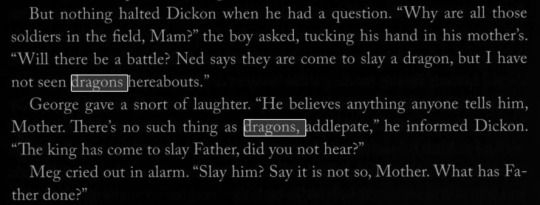


The only scene worth watching in TWQ btw!!

#richard iii#the white queen#aneurin barnard#david oakes#george duke of clarence#richard duke of gloucester#margaret duchess of burgundy#queen by right
16 notes
·
View notes
Photo

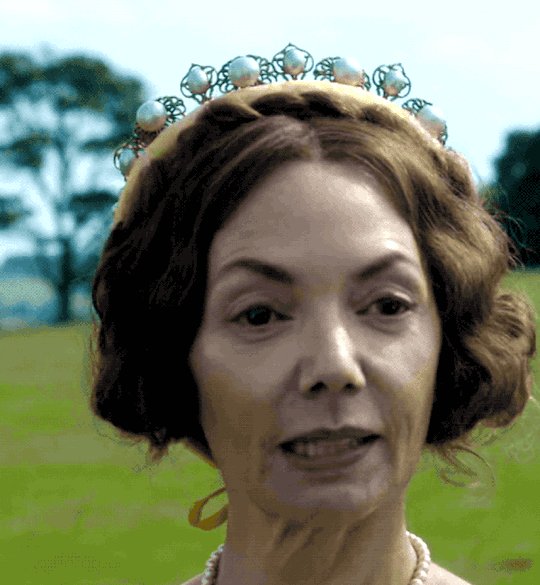


(Almost) Every Costume Per Episode + Margaret of Burgundy’s pearl tiara in 1x03
#The White Princess#TheWhitePrincessEdit#perioddramaedit#weloveperioddrama#period drama#costumeedit#Burgundy#Margaret of Burgundy#costumes#costume drama#Almost Every Costume Per Episode#historical drama#Awkward-Sultana
21 notes
·
View notes
Text
The duke of Clarence before-named, brother to king Edward (IV), had been fully reconciled to the king by the mediation of his sisters, the duchesses of Burgundy and Exeter (Margaret of York and Anne of York), of whom, the one without the kingdom, and the other within it, entreated the duke to make peace with his brother."
-Croyland Chronicle
#it's interesting because Cecily Neville is often given the credit for reconciling George to his brother by historians#but actually contemporary evidence doesn't emphasize her role at all; instead it highlights her daughters: Anne and especially Margaret#Cecily's one of the MANY people mentioned in the Arrivall - it's Margaret who's once again given a distinctive emphasis#and is often credited well by historians#but Anne of York is completely overlooked and it's extremely unfair#Croyland highlights ANNE not her mother. But historians opt for the opposite route#and it sucks because we KNOW Anne was very close to her brothers#she evidently chose her birth family over her husband#Edward's (in)famous indulgence of his siblings began with HER - not their brothers - and he was clearly supportive of her affair as well#George literally hosted her divorce trial#once again: it's really frustrating how the York sisters are given such less attention compared to their brothers#even Margaret - who's the most famous - is mainly known for her role in *Henry VII's* reign rather than her brothers'#Anne of York is given only scattered mentions...and Elizabeth is ignored entirely :/#margaret of york duchess of burgundy#anne of york duchess of exeter#george of Clarence#15th century#the wars of the roses#english history#my post#edward iv#queue
14 notes
·
View notes
Text
Margaret of Austria is Shipwrecked and King Henry VII of England Writes to Her at Southampton – 1497
Probably by Pieter van Coninxloo
Diptych: Philip the Handsome and Margaret of Austria
about 1493-5
https://www.nationalgallery.org.uk/paintings/GROUP20
When King Charles VIII of France put into motion his plans to extend his power basis into Italy, he attacked Naples which belonged to the sphere of influence of King Ferdinand of Aragon. Holy Roman Emperor Maximilian I concluded an anti-French…

View On WordPress
#Burgundian history#Charles V#Duke of Burgundy#Ferdinand#Henry VII#Holy Roman Emperor#Isabella#Juan Prince of Asturias#Juana of Castile#King of Aragon#King of England#Margaret of Austria#Maximilian I#medieval history#Philip the Handsome#Queen of Castile#Spanish history#Women’s history
12 notes
·
View notes
Note
I saw a post going around about Henry V's looks, so I wonder if you happen to know the hair colour of his siblings? I know the hair colours of some Plantaganets, but frankly I've never looked for those of Henry's siblings before.
Hello! So, there's really only information about what colour hair three of Henry V's five siblings had and only one case where I feel we can be 99.9% certain of the hair colouring.
I'll go into a lot more detail (with photos! and my trademark rambling!) below the cut but basically:
Thomas, Duke of Clarence: unknown
John, Duke of Bedford: dark brown
Humphrey, Duke of Gloucester: probably dark brown
Blanche of England: possibly blonde or red
Philippa of England: unknown
John, Duke of Bedford's hair is depicted as brown in two extant manuscripts that belonged to him. Depictions in manuscripts are problematic as far as "true likenesses" go. The artist might not know what their subject look like so they cannot make a true-to-life likeness even if they wanted to. Or they might be making an idealised or generic portrait where what's important is more what the figure represents (i.e. status as king, queen, duke etc.) rather than what the figure really looked like.
But these two manuscripts depict John in what appears to be an effort to depict a reasonable likeness of him (you can tell by the nose). The Bedford Hours has the most detailed and fine portrait, where he has dark brown hair, an aquiline nose and it seems grey eyes (the weird five o'clock shadow around the side of his face and under his jaw is probably the result of pigment wearing off, though).
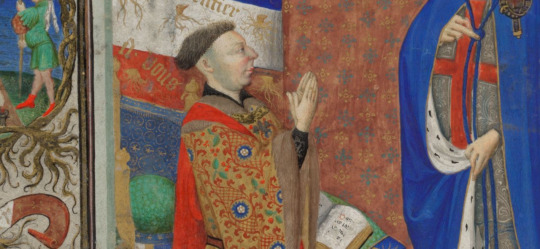
The portraits in the Salisbury Breviary are overall less detailed but are still personalised enough (see: the nose) that we can say that they were probably made to resemble him:


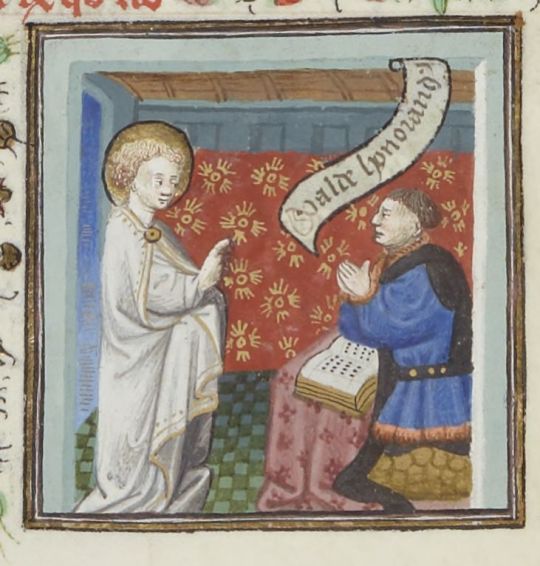
And if that's not enough, his remains were discovered in 1860 and his hair colour was noted as "dark" or "black". The remains themselves were noted as being blackened so I'd guess the processes of embalming/decay probably darkened his dark brown hair to black.
The flip side of the manuscript problem is Humphrey, Duke of Gloucester, where we have four different depictions from four different contemporary/near-contemporary manuscripts, where his hair ranges from light brown (or dark blond, if you'd rather) to dark brown to black, including one where he looks bald but if you zoom in close enough, he has a very short crop of dark hair underneath his crown.

The first is from the Talbot-Shrewsbury Book (made in Rouen, 1444/5), the second from the presentation copy of John Capgrave's Commentary on Exodus (made in England, c. 1440); the third from the Psalter of Humfrey of Gloucester (made in England in the second quarter of the 15th century, before 1447) and the fourth from the St. Albans Benefactor Book (made in St Albans monastery, begun 1380 and finished c. 1540). All of these can be connected with people who knew Humphrey and thus knew what he looked like (though it's not clear when the fourth was made, it may have been long after his lifetime), though as with all manuscripts, he may have been represented as a generic royal duke/patron/donor instead of an attempt being made at a reasonable likeness.
What is striking about them is how different they are not only from the uniform likenesses of John but from each other. If second and third have the same type of hair colour, the faces are noticeably different. None of them resemble the copy of Humphrey's portrait that closely either (though, of course, a portrait has a lot more room for detail and personalisation).
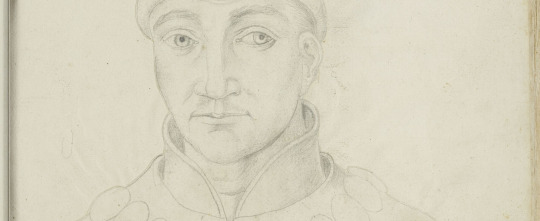
However, the second and third are the most interesting in terms of hair colour because they both depict Humphrey with dark brown hair and were both made in Humphrey's lifetime by English illuminators - the third was almost certainly commissioned by Humphrey himself - so they have the best chance of being reasonably true to how he looked.
But in case that sounds too easy an answer, Humphrey's corpse was also rediscovered in the 1700s and his hair is said to have been yellow. Elizabeth, countess of Moira and a "proto-archaelogist", took some of the hair, noted the colour and that it was strong enough to be woven "Bath rings". She also suggested that the colour of the hair was not as it had been in life but it was "the nature of hair to gain that yellowish hue in the grave" - in other words, Humphrey may have been grey- or white-haired at death and the materials used in embalming bleached or discoloured his hair.
Although being the most obscure sibling, Blanche of England is the perhaps the only other sibling where there's any information about her hair colour. We have this image which I believe is a copy of a near-contemporary image of her (in the centre):

I can't remember or find where I got the information about it being a copy of a near-contemporary original, though, so I might be wrong. As we can see, she appears to have hair that is somewhere on the blond to red spectrum (I read it as ginger but though this is the highest resolution I can find, it's clearly poor quality (cf. the lines on the faces) so the colours might be distorted). The painting might represent Blanche as an idealised queenly figure rather than an attempt to represent her truthfully - though the fact it depicts her with a crown similar to the Palatine Crown she brought as her dowry is suggestive that they were trying to depict her in a way that made her easily identifiable.
Her name, "Blanche", might also be suggestive, as she was named after her grandmother, Blanche of Lancaster, Duchess of Lancaster (daughter of Henry of Grosmont, the first wife of John of Gaunt) whose hair was described by Chaucer as golden:
For every heer upon hir hede,
Soth to seyn, hit was not rede,
Ne nouther yelow, ne broun hit nas;
Me thoghte, most lyk gold hit was. (The Book of the Duchess, ll. 855-858)
Of course, it's possible that Blanche was merely named in honour for her grandmother and there was no resemblance. But given Blanche means "white", it's possible that she was named in honour of her grandmother and because her hair was a similar colour.
I'm not aware of any contemporary surviving contemporary images of Philippa of England, though we have an image from 1590 that shows her with blonde (reddish-blonde?) hair and an stained glass window from the 19th century that shows her with dark hair:
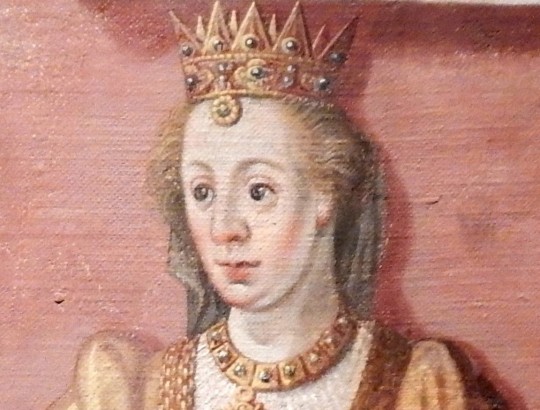

We do have a near-contemporary image of Thomas, Duke of Clarence but... it's his alabaster tomb effigy and he's shown wearing a helm and is without moustache and beard so we have no idea of the colour of his hair.
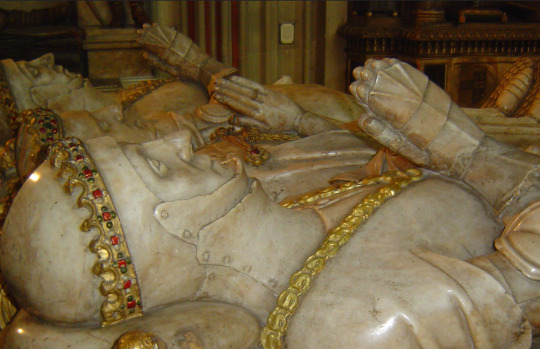
But the Lancaster siblings probably every hair colour in their gene pool. Henry IV was said to have had "russet" hair when his tomb was opened (though we can't dismiss the possibility that his hair only appeared russet due to the way that red pigment can decay slower than others). Mary de Bohun is depicted as blonde in donor portraits in her psalter and Book of Hours (though it might be an idealised portrait than realistic). Their paternal grandmother, Blanche of Lancaster, was blond, their great-grandparents Philippa of Hainault and Edward III appear to have been black-haired and blonde respectively and red-hair is strongly associated with the Plantagenet line. So while Henry V, John and Humphrey all seeming to have dark brown hair is perhaps indicative of a family trait, I don't think that means Thomas, Blanche and Philippa must have had it too - and Blanche may well have been blonde or ginger.
#thomas duke of clarence#john duke of bedford#humphrey duke of gloucester#blanche of england#philippa of england#text posts#yoghurtbattle#asks#(as for the spouses margaret holland has blond hair in some manuscripts#catherine de valois's effigy had strands of brown hair#and there's a lock of blond hair said to be taken from jacqueline of hainault's tomb though they also said they couldn't find her tomb)#(no information about eleanor cobham or anne of burgundy or jacquetta of luxembourg i believe)#lancasterlings
10 notes
·
View notes
Text
I feel bad for Margaret of York that this portrait is always used to represent her

fuck ass proportions!!!
#she's got a shoulder-head ratio like a bratz doll v____v#even if you ignore the obviously-shrunken body the facial proportions are just clearly out of wack too#its so odd bc it's not as if portraits of the nobility from the late medieval period are normally this bad#a lot of medieval art of like famous ppl--portraits that arent full paintings--arent even bad per se#like the most well-known contemporary image of her father richard duke of york isnt BAD its just not a full painting#so it's quite unsatisfactory to a modern viewer wondering what they looked like#margaret's husband charles the bold duke of burgundy had several splendid paintings that i think many would be surprised at the quality of#text post#medieval art#every time i see this painting it makes me unhappy#i know there are other better images used to represent her but i dont see them as prominently so im guessing theyre not contemporary?#i havent done my research into them so dont take that as fact#usually in a case like this. if the most well-known image of someone is this fuck ugly#it's got the most valid historical provenance for representing them. which is a shame#no human being has ever looked like this portrait of margaret of york duchess of burgundy#it hurts. it's painful to behold
0 notes